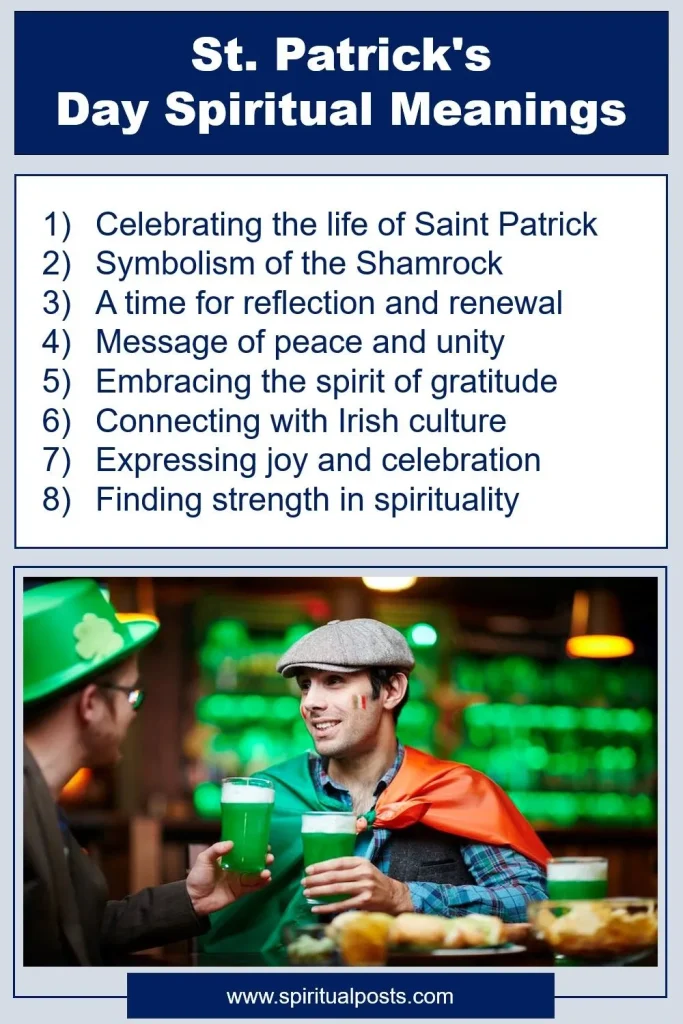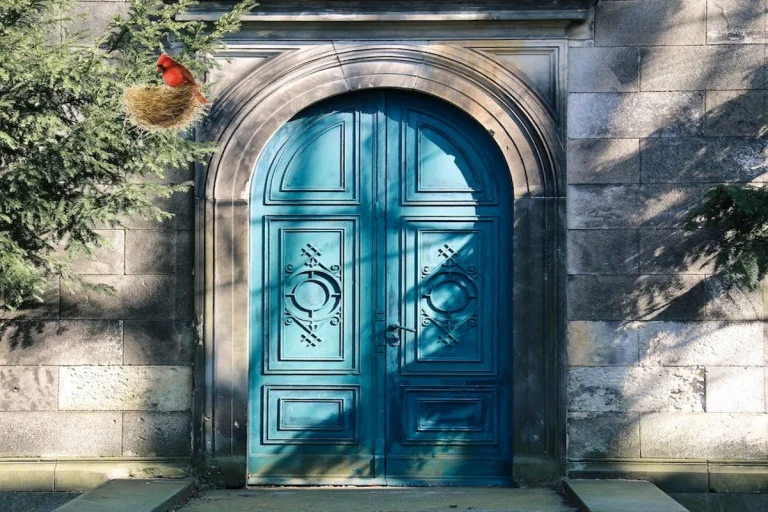8 Spiritual Meanings of St. Patrick’s Day, History & Background

St. Patrick’s Day is an annual holiday celebrated on March 17th. It commemorates the life of St. Patrick, the patron saint of Ireland, who was born in Roman Britain during the late 4th century. St. Patrick is renowned for his efforts in converting the Irish people to Christianity.
Originally, St. Patrick’s Day held religious significance for the Irish population. However, over time, it has evolved and taken on new meanings for people of Irish descent worldwide.
On this day, various traditions are observed, including religious services, parades, and other festivities. Many legends have arisen around St. Patrick, such as the belief that he drove the snakes out of Ireland and used the shamrock as a symbol to explain the concept of the Holy Trinity.
Though blue was originally associated with St. Patrick, green has become the predominant color associated with the holiday.
Cities with significant Irish immigrant populations, such as Boston and New York City, have been hosting extensive celebrations, including elaborate parades, since the 18th century.
In this blog, we will delve into the spiritual meaning, history, background, and significance of St. Patrick’s Day.
We’ll explore who celebrates it, when it is celebrated, and the various customs and traditions associated with this special day.

St. Patrick’s Day is celebrated to honor Saint Patrick, the patron saint of Ireland, and to commemorate the arrival of Christianity in Ireland. It has evolved from a religious observance to a secular celebration of Irish culture, marked by parades, music, special foods, dances, and the color green, which is commonly associated with the saint. The holiday’s significance has broadened, thanks to Irish immigrants spreading their heritage and traditions worldwide.
What is St. Patrick’s Day and When It is Celebrated?
St. Patrick’s Day is a religious and cultural holiday celebrated on March 17th, honoring Saint Patrick, the patron saint of Ireland, and the arrival of Christianity in the country.
It is observed worldwide, with significant celebrations in Ireland and the United States. The holiday includes religious observances, vibrant parades, and an abundance of green-themed displays and decorations.
Many legends surround Saint Patrick, such as driving snakes out of Ireland and using the shamrock to explain the Holy Trinity. St. Patrick’s Day has evolved to encompass not only religious significance but also cultural celebrations that honor Irish heritage and traditions.
Cities with substantial Irish immigrant populations, particularly in the US, hold extensive celebrations, including elaborate parades.
This multifaceted holiday serves as a tribute to Saint Patrick’s legacy, his contributions to Christianity in Ireland, and the enduring spirit of the Irish people worldwide.
St. Patrick’s Day History and Background
St. Patrick, originally named Maewyn Succat, was born in Roman Britain in the late 4th century. At the age of sixteen, he was captured by Irish pirates and taken to Ireland as a slave.
During his captivity, he embraced Christianity and developed a deep spiritual connection. After six years of enslavement, he escaped and returned to his homeland.
Later, St. Patrick felt a calling to return to Ireland as a missionary to spread Christianity. He spent years traveling across the country, converting pagans to Christianity and establishing churches, schools, and monasteries.
His efforts had a profound impact on the island’s religious landscape, and he is credited with playing a significant role in the Christianization of Ireland.
St. Patrick’s Day Spiritual Meanings and Cultural Significance

St. Patrick’s Day, celebrated on March 17th each year, holds deep spiritual meanings and significance for millions of people around the world.
While it is widely known as a day of revelry, parades, and wearing green, the holiday’s spiritual roots are equally important and worth exploring.
1. Celebrating the Life of St. Patrick
At its core, St. Patrick’s Day is a celebration of the life and work of St. Patrick, the patron saint of Ireland. St. Patrick was a Christian missionary who played a pivotal role in bringing Christianity to Ireland during the fifth century.
His dedication and unwavering faith in spreading the teachings of Christ have made him an emblem of spiritual commitment and devotion.
2. The Symbolism of the Shamrock
The shamrock, a three-leafed plant, is closely associated with St. Patrick’s Day. According to legend, St. Patrick used shamrock to explain the concept of the Holy Trinity (Father, Son, and Holy Spirit) during his missionary work in Ireland.
As a result, the shamrock became a powerful spiritual symbol, representing the unity of the divine trinity and the principles of faith, hope, and love.
3. A Time for Reflection and Renewal
St. Patrick’s Day serves as a reminder for people to reflect on their spiritual journey and renew their faith. It prompts individuals to take stock of their beliefs, values, and the impact of their actions on others.
The holiday encourages self-improvement and a renewed commitment to living with kindness, compassion, and empathy.
4. Spreading the Message of Peace and Unity
St. Patrick’s Day transcends religious boundaries and stands as a testament to the universal values of peace and unity.
It reminds people of the importance of harmony among diverse communities and the potential for positive change through understanding and cooperation.
5. Embracing the Spirit of Gratitude
In the spirit of the holiday, individuals often express gratitude for the blessings in their lives. Whether it’s through prayers, acts of kindness, or spending time with loved ones, St. Patrick’s Day encourages people to count their blessings and appreciate the goodness around them.
6. Connecting with Irish Heritage and Culture
For those with Irish ancestry or a fondness for Irish culture, St. Patrick’s Day offers a unique opportunity to connect with their roots.
It serves as a bridge between generations, allowing families and communities to pass down cultural traditions, stories, and values to the younger members.
7. Finding Strength in Spirituality
St. Patrick’s Day reminds individuals of the strength and solace that can be found in spirituality. It encourages people to turn to their faith during challenging times, finding comfort in knowing they are not alone on their journey.
8. Expressing Joy and Celebration
While St. Patrick’s Day has deep spiritual significance, it is also a day of joy and celebration. It embodies the idea of finding joy in one’s beliefs and taking a moment to celebrate life’s blessings with enthusiasm and laughter.
Legends, Myths, and Superstitions About Saint Patrick’s Day
| Popular Myths, Legends, and Superstitions about St. Patrick’s Day | Spiritual Meanings, and Significance |
|---|---|
| 1. Driving the Snakes out of Ireland | Symbolizes the triumph of Christianity over pagan beliefs and evil forces. |
| 2. Using the Shamrock to Explain the Trinity | Represents the Holy Trinity: Father, Son, and Holy Spirit, aiding in the spread of Christianity. |
| 3. Wearing Green for Good Luck | Green symbolizes rebirth, luck, and protection, linking to the renewal of faith and divine blessings. |
| 4. Finding a Four-Leaf Clover for Luck | The four leaves represent hope, faith, love, and luck, signifying blessings and divine favor. |
| 5. Leprechauns and their Hidden Pots of Gold | Leprechauns embody the elusive nature of spiritual truths, teaching the value of inner wealth. |
| 6. Avoiding Bad Luck by not Tipping the Hat | A gesture of respect to the spiritual significance of the day and honoring St. Patrick’s memory. |
| 7. Parades to Celebrate Irish Heritage | Unity and pride in the Irish culture, fostering a sense of community and appreciation for traditions. |
1) Driving the Snakes out of Ireland
One of the most famous legends associated with St. Patrick is that he drove all the snakes out of Ireland.
While this tale might not be historically accurate, it carries a symbolic meaning. Snakes were seen as pagan symbols and representations of evil forces.
St. Patrick’s act of “driving the snakes out” is thought to symbolize the triumph of Christianity over pagan beliefs and the banishment of negative influences.
It represents the spreading of God’s light and goodness across the land, purifying Ireland spiritually.
2) Using the Shamrock to Explain the Trinity
Another fascinating tale is how St. Patrick used a shamrock, a three-leaf clover, to explain the concept of the Holy Trinity during his missionary work.
He related the three leaves of the shamrock to the three persons of the Trinity: the Father, the Son (Jesus Christ), and the Holy Spirit.
This simple yet profound analogy helped the Irish people grasp the complex Christian belief of three distinct persons in one divine Godhead. As a result, the shamrock became a powerful symbol of Christianity’s influence on Ireland.
3) Wearing Green for Good Luck
On St. Patrick’s Day, people worldwide don green clothing and accessories as a way to celebrate the holiday. Green has long been associated with Ireland and its lush landscape.
In a spiritual sense, green symbolizes renewal, growth, and luck. Wearing green on this day is like adorning ourselves with the blessings of rebirth and protection. It is a way of honoring nature’s vitality and inviting good luck into our lives.
4) Finding a Four-Leaf Clover for Luck
The search for a four-leaf clover is a charming superstition linked to St. Patrick’s Day. According to folklore, each leaf of the clover has a meaning: hope, faith, love, and luck.
Finding a rare four-leaf clover is considered exceptionally lucky because it represents the convergence of all these positive aspects.
In a spiritual context, discovering such a clover can be seen as a sign of divine favor and blessings.
5) Leprechauns and their Hidden Pots of Gold
Leprechauns, the mischievous little folk of Irish folklore, are often associated with St. Patrick’s Day.
According to legend, they are skilled shoemakers who hide their pots of gold at the end of rainbows. While leprechauns may seem whimsical, their spiritual significance lies in the idea of elusive truths.
They teach us to value the inner treasures of our hearts and minds, which cannot be found with material possessions.
6) Avoiding Bad Luck by not Tipping the Hat
A curious superstition on St. Patrick’s Day involves not tipping one’s hat. In Irish folklore, it was believed that revealing your respect by tipping your hat might accidentally let out the luck you’ve gathered for the day.
This friendly custom reminds us to honor the spiritual significance of the holiday and show respect for St. Patrick’s memory and the traditions associated with the day.
7) Parades to Celebrate Irish Heritage
Parades are an integral part of St. Patrick’s Day celebrations in cities with Irish heritage. These vibrant processions reflect unity and pride in Irish culture.
They foster a sense of community and appreciation for the customs and history passed down through generations.
Parades are a joyful expression of the Irish spirit, emphasizing the importance of cultural heritage and maintaining a connection to one’s roots.
Final Words
St. Patrick’s Day encompasses far more than just parades and festivities; it carries profound spiritual meanings and significance.
From celebrating the life of St. Patrick to embracing unity, gratitude, and spirituality, the holiday serves as a reminder of the enduring human spirit and the power of faith and love.
It serves as a global bridge, uniting people of diverse backgrounds in joy and celebration. As we honor the legacy of St. Patrick, we also embrace the spirit of unity, friendship, and gratitude that this special day brings.
You Might Also Like
1) Actor Superstitions of Stepping with the Right Foot First
2) Spitting in Someone’s Mouth Spiritual Meaning: Bad or Good?
3) Spiritual Meaning of Bird Pooping on You (Good Luck!)
4) Spiritual & Biblical Meanings of Flickering Lights (Bad!)





